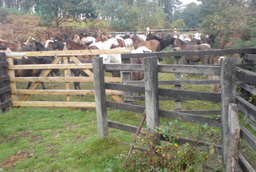| At September's Verderers Court, in his Announcements and Decisions, the Official Verderer, Dominic May, updated the Court on the fate of funding for High Level Stewardship, post Brexit, along with an appreciation of the achievements of the scheme. |
I am pleased to inform the Court that the Chancellor of the Exchequer announced on 13th August that agri-environment schemes will be fully funded, even when these projects continue beyond the UK's departure from the EU. Our Higher Level Stewardship, the largest in the country, runs until February 2020, and we can continue doing so much good work improving the New Forest with this very important financial backing.
The New Forest suffers over time by a ratchet affect. No one activity will by itself ruin it, and each disturbance taken in isolation may on the face of it appear negligible. But add up every human intervention, such as artificial drainage, car parks, gravel tracks, utility structures such as telegraph poles or pumping stations, and incrementally over time we experience the significant loss of grazing, loss of landscape amenity, loss of habitat, and loss of good environmental condition.
Our HLS funds projects to conserve or improve the ecology and environment of the New Forest Crown Lands. We find ourselves in an impoverished financial climate within the public sector, so the £2,000,000 per year which we are spending from the HLS is absolutely fundamental to the future good condition of the New Forest.
 This money enables us to turn the clock back to remove previous man-made interventions. We are improving the landscape amenity of the forest. We are improving grazing for the benefit of the forest stock, which are the architects of our beautiful New Forest landscape.
This money enables us to turn the clock back to remove previous man-made interventions. We are improving the landscape amenity of the forest. We are improving grazing for the benefit of the forest stock, which are the architects of our beautiful New Forest landscape. Our wetland restorations remove man-made drainage, so damaging to the ecology encourage the re-establishment of the flood plain, depositing beneficial organic matter on the forest rather than it being washed out to sea. And a positive by-product is to reduce flood risk downstream.
We are experiencing some concerted opposition to our wetland work: happily we live in a democracy with its foundation on freedom of speech, so this opposition is entirely proper. It is therefore up to us to win the debate, and provide justification for our plans. Some opposition is based on scientific principles; some on the use of public money; and some is based on what people are used to seeing in "their" area. However, the time horizon of us humans is very short, compared to the 937 years since the legal governance of the New Forest was formalised in 1079.
The HLS-funded terrestrial work on the New Forest has increased in importance and is providing ecological benefits as well as improved grazing. In the last year the HLS has paid to remove 136 acres of rhododendron. It has paid to restore 56 acres of lost lawns. It has paid to remove self-seeded non-native conifers over 316 acres of open forest. It has paid heather removal over 32 acres. And the HLS has paid for 355 acres of bracken control.
 We are keen that the HLS leaves a legacy for the future. This year the HLS has funded new stock pounds at Woodgreen, Holmsley, Appleslade and Woodfidley; these are built in hardwood for longevity.
We are keen that the HLS leaves a legacy for the future. This year the HLS has funded new stock pounds at Woodgreen, Holmsley, Appleslade and Woodfidley; these are built in hardwood for longevity.With the inexorable increase in the number of cars, we are seeing a huge loss of grazing and thus habitat interest: areas of grass on the edge of roads or outside houses are being lost to bare gravel. You have all seen it. The causes are widespread: over-running the verge at junctions; dog walkers not using car parks; car parking in villages; ignorance from visitors. We are therefore funding a programme of works which will protect eroded verges, and in the longer term allow re-growth of natural vegetation. This verge restoration programme has been slow to get going, but this year the HLS has funded work in Woodgreen and Fritham, with plans in and around East Boldre in the near future.
 |
| Himalayan balsam (Impatiens glandulifera) in middle distance along the riverbank at Newbridge in the New Forest. |
This summary of our Higher Level Stewardship achievements enables everyone to understand how important it is to the New Forest, and the Chancellor's confirmation of continued funding to 2020 will enable us to keep up our very important work.
Dominic May
Official Verderer
21st September 2016
| --used with permission with our thanks. This is part of the NFA's initiative to publicise good works on the Forest. Announcements and Decisions by the Verderers ordinarily do not enter the public record until the minutes of the whole Court, including the in camera sessions, are approved at the subsequent month's sitting, unless directly reported by the local papers. The High Level Stewardship scheme is an Environmental subsidy, as evidenced by the word "Stewardship". The New Forest HLS scheme is England’s largest. Whilst this statement from the Official Verderer confirms funding for the current scheme to 2020, there will still be post Brexit implications to subsequent schemes, other habitat funding, agricultural funding and environmental and habitat protections safeguarded under EU legislation, which may need to be back-stopped or re-invented before the formal exit process begins. The NFA spoke at the July 2016 Verderers Court about some related issues in their Presentment Brexit and The Forest. |
